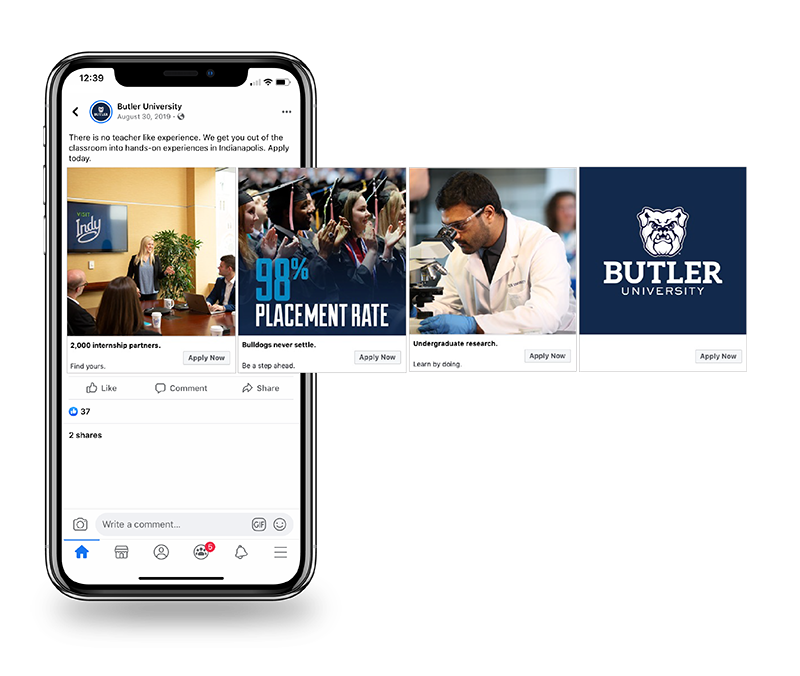One of the biggest challenges in higher education marketing is the perpetual dilemma enrollment management teams face: Spend vs. Outcome. Does my audience include enough of the right prospective students and parents who will convert, enabling me to deliver the required cohort? Is this channel the best place to publish to those audiences? Is this spend going to bring back the return on my investment? Parsing all of the outputs from these audiences and channels into a cohesive plan of action can feel daunting. But not if you have the right strategy in place, first.
Undertaking strategic planning for enrollment management rooted in audience analysis prior to the launch of your student recruitment campaign gives you a chance to evaluate your audience segments to see if they align with what exists on channel, or if a new audience segment should be sought out. This prevents you from spending any of your precious marketing dollars on a specific audience, only to find out it isn’t large or receptive enough to merit the investment. Of course your historical student recruitment practices mean you have the data and experience to understand which targets are likely to yield comparably high return. But where are they looking for information relative to the unique value propositions of your institution? What is their current “path to purchase” in light of emerging and evolving media channels? Re-evaluating projected audience targets prior to your campaign also allows you to evaluate your distribution channel mix as well.
Simply put, a billboard isn’t likely to be a good investment if you’re trying to reach a rural, digital-heavy students and parents, for example, and understanding what goes into the decision-making process of segments prior to launch should illuminate some clear “start here” options for content distribution.
Measurement is always going to be an essential part of evaluating how and where to spend on marketing. The trouble begins when you want to do an apples-to-apples comparison of all your marketing channels. You quickly find this is impossible — like “shoving-toothpaste-back-into-a-tube-while-being-launched-into-space” impossible. Thankfully, we can evaluate the conversion points that exist for the audience, thus bringing some parity to the myriad of engagement metrics that exist in everything traditional or digital.
The more finite your tracking is at the start of your campaign, the better the information can allow you to be more flexible in how you are applying your spend and on what channel. Waiting for the midpoint of a campaign to check in means there was likely valuable input earlier on that might have been telling you to increase spending on one channel that was converting above its baseline and remove or reduce another channel that was sapping precious budget for little return.
Parents play an outsized, influential – and somewhat oddly muted – role in the college selection process, and should be cultivated with targeted messages in parent-specific channels as to academic outcomes, placement rates, campus life and safety, and, as applicable, unique ways your institution can help with financial considerations.
And how about alumni? No doubt that your development function is constantly building meaningful connections with this immensely influential audience, but it may be useful to dial them into your practice of strategic planning for enrollment management. This credible, motivated and passionate group of advocates has significant capacity to affect preference and serve as an “intake valve” for prospective students. Are you developing a strata of messaging, both content and channel selection, that appeal directly to this audience? If nothing else, the process of dialing in this group generates creative opportunities for cross-departmental brainstorming and cooperation between enrollment management and development.
Consider ways to engage and “deputize” faculty and staff, too; thoughtfully planned employee advocacy – with which MKR can help – can be a surprisingly powerful recruitment tool, when it is creatively fostered (using synchronous content, made easily accessible) and carefully amplified through numerous social channels that employees – and prospective students and their families – already use.
The tectonic plates shifting beneath the foundations of higher education can create immense instability. Or, with careful strategic planning and the foresight it provides, can instead provide opportunities for new momentum as you ride the waves of change.

MKR created paid social media plans for Facebook to give Butler University more control over their media allocations, so they could focus dollars where they were working the hardest.

